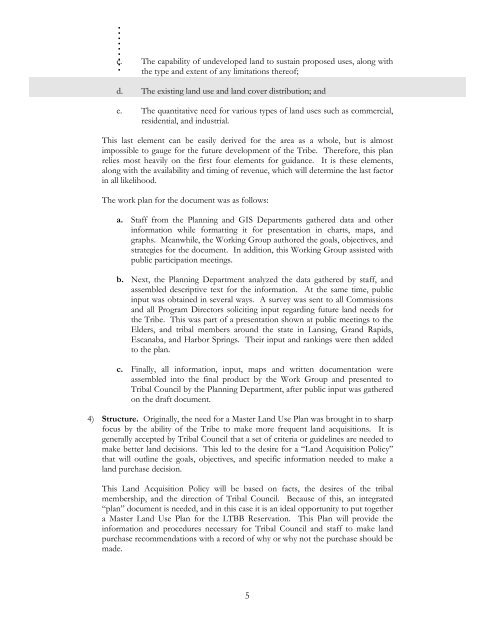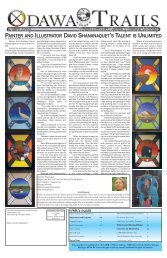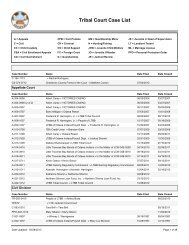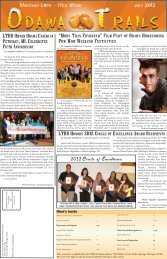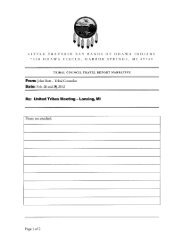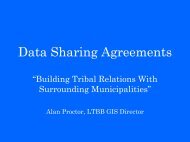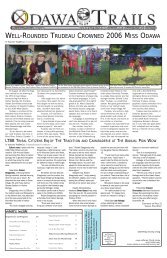LTBB Master Land Use Plan - Little Traverse Bay Bands of Odawa ...
LTBB Master Land Use Plan - Little Traverse Bay Bands of Odawa ...
LTBB Master Land Use Plan - Little Traverse Bay Bands of Odawa ...
Create successful ePaper yourself
Turn your PDF publications into a flip-book with our unique Google optimized e-Paper software.
.<br />
c. The capability <strong>of</strong> undeveloped land to sustain proposed uses, along with<br />
the type and extent <strong>of</strong> any limitations there<strong>of</strong>;<br />
d. The existing land use and land cover distribution; and<br />
e. The quantitative need for various types <strong>of</strong> land uses such as commercial,<br />
residential, and industrial.<br />
This last element can be easily derived for the area as a whole, but is almost<br />
impossible to gauge for the future development <strong>of</strong> the Tribe. Therefore, this plan<br />
relies most heavily on the first four elements for guidance. It is these elements,<br />
along with the availability and timing <strong>of</strong> revenue, which will determine the last factor<br />
in all likelihood.<br />
The work plan for the document was as follows:<br />
a. Staff from the <strong>Plan</strong>ning and GIS Departments gathered data and other<br />
information while formatting it for presentation in charts, maps, and<br />
graphs. Meanwhile, the Working Group authored the goals, objectives, and<br />
strategies for the document. In addition, this Working Group assisted with<br />
public participation meetings.<br />
b. Next, the <strong>Plan</strong>ning Department analyzed the data gathered by staff, and<br />
assembled descriptive text for the information. At the same time, public<br />
input was obtained in several ways. A survey was sent to all Commissions<br />
and all Program Directors soliciting input regarding future land needs for<br />
the Tribe. This was part <strong>of</strong> a presentation shown at public meetings to the<br />
Elders, and tribal members around the state in Lansing, Grand Rapids,<br />
Escanaba, and Harbor Springs. Their input and rankings were then added<br />
to the plan.<br />
c. Finally, all information, input, maps and written documentation were<br />
assembled into the final product by the Work Group and presented to<br />
Tribal Council by the <strong>Plan</strong>ning Department, after public input was gathered<br />
on the draft document.<br />
4) Structure. Originally, the need for a <strong>Master</strong> <strong>Land</strong> <strong>Use</strong> <strong>Plan</strong> was brought in to sharp<br />
focus by the ability <strong>of</strong> the Tribe to make more frequent land acquisitions. It is<br />
generally accepted by Tribal Council that a set <strong>of</strong> criteria or guidelines are needed to<br />
make better land decisions. This led to the desire for a “<strong>Land</strong> Acquisition Policy”<br />
that will outline the goals, objectives, and specific information needed to make a<br />
land purchase decision.<br />
This <strong>Land</strong> Acquisition Policy will be based on facts, the desires <strong>of</strong> the tribal<br />
membership, and the direction <strong>of</strong> Tribal Council. Because <strong>of</strong> this, an integrated<br />
“plan” document is needed, and in this case it is an ideal opportunity to put together<br />
a <strong>Master</strong> <strong>Land</strong> <strong>Use</strong> <strong>Plan</strong> for the <strong>LTBB</strong> Reservation. This <strong>Plan</strong> will provide the<br />
information and procedures necessary for Tribal Council and staff to make land<br />
purchase recommendations with a record <strong>of</strong> why or why not the purchase should be<br />
made.<br />
5


